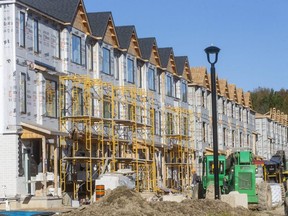'Housing crisis is real': London's home ownership rate lowest in province

Article content
London’s economy is much hotter than six years ago, but its home ownership rate remains dead last among major Ontario cities and has even slid a bit since the numbers were last crunched in 2016.
Latest Statistics Canada figures suggest the home ownership dream remains beyond the reach of many in the London area, especially young adults, with the city running an ownership rate – the ratio of the population that owns their home – of 62.6 per cent in 2021.
That’s down from the 64-per-cent rate that also ranked London last in 2016, and below the latest Ontario (68.4 per cent) and national (66.5 per cent) rates, both of which also declined.
Just a few hours down Highway 401, by contrast, Windsor posted Ontario’s third-highest ownership rate, rising to 72.5 per cent in the latest snapshot from 71.7 per cent, only one of two Ontario centres, along with Belleville, to see their rates rise.
Oshawa topped the provincial list, based on the last census in 2021, at 74.9 per cent home ownership.
Several factors are behind London’s latest rate drop, key among which is the recent run-up in home prices that has left many unable to enter the market, said Mike Moffatt, an assistant professor at Western University’s Ivey business school.
“I think this really confirms that the housing crisis is real,” he said Wednesday.
Between 2015 and 2020, London-area home prices rose steadily before skyrocketing after the COVID-19 pandemic began in 2020, reaching an all-time high of $825,000 this February.
Prices in the London-area market have dropped since, to an average of $648,000 in August, amid inflation-fighting interest rate hikes by the Bank of Canada that have driven up mortgage and other borrowing costs.
While home ownership rates dropped across all age groups in London, young adults saw the biggest declines: to 50.5 per cent from 53.6 per cent for those aged 30 to 34, and to 58.1 per cent from 62.5 per cent for those 35 to 39.
“I think it’s eye-opening to a lot of people to see how much the proportion of young homeowners has fallen,” Moffatt said.
“I think there was this idea that, ‘Yes, things were bad but young people are exaggerating how bad they are.’ But this (housing crisis) is hurting young people today.”
It was a similar picture nationally, with Statistics Canada reporting the number of renter households grew at more than twice the rate of owner households between 2011 and 2021.
London’s rate, affected by a student population numbering in the tens of thousands, also could also be affected by immigration levels in recent years. Many newcomers tend to rent for several years before entering the housing market, said Robin Wiebe, a senior economist with the Conference Board of Canada.
“London certainly does seem to have had a high proportion of newcomers relative to its population,” he said.
The London market, for counting purposes, includes St. Thomas and Strathroy-Caradoc and parts of Middlesex and Elgin counties.
The local housing crisis also has been compounded by the pace of London’s growth in recent years, said Don Kerr, a demographer and professor at King’s University College.
London was Ontario’s fastest-growing community between 2016 and 2021, its population expanding by a whopping 10 per cent.
But while the number of housing starts has grown in the last couple of years, it hasn’t been enough to meet the demand, pushing prices up, Kerr said.
“For this period of growth, the number of potential homes available has clearly lagged behind population growth,” he said, adding the region’s after-tax median household income, which was $71,000 in 2020, also lags many major urban centres in Ontario.
“We were not alone on this front, as 14 of 16 census metropolitan areas across Ontario also saw their home ownership rates decline, some to a greater extent than London,” Kerr said.
“It was just that our home ownership rate was already relatively low back in 2016.”
jjuha@postmedia.com
Twitter.com/JuhaatLFPress
HOME OWNERSHIP RATES, 2021
Canada: 66.5 per cent
Ontario: 68.4 per cent
ONTARIO’S TOP RATES
1. Oshawa: 74.9 per cent
2. Barrie: 73.4 per cent
3. Windsor: 72.5 per cent
LONDON
62.6 per cent, lowest among 16 Ontario major centres surveyed
Source: Statistics Canada








Postmedia is committed to maintaining a lively but civil forum for discussion. Please keep comments relevant and respectful. Comments may take up to an hour to appear on the site. You will receive an email if there is a reply to your comment, an update to a thread you follow or if a user you follow comments. Visit our Community Guidelines for more information.